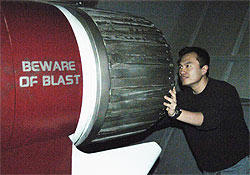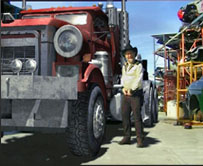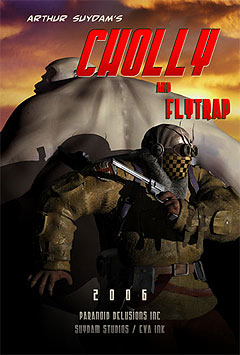Date
of publishing: 6th January 2006
 In 1985, Eric Chu started out in the animation business
as a storyboard artist. A few years later, he moved
to Asia and co-founded Fisheye Films where he acted
as Creative Director for television commercials. Upon
returning to Canada, Eric found work in Vancouver BC
as Art Director. He recently produced a short film featuring
Optimus Prime, which has attracted the interest of Hasbro
and Tom DeSanto, producer of the upcoming Transformers
movie. But he is more known for his work as concept
art designer on the cylons from the new Battlestar Galactica
series.
In 1985, Eric Chu started out in the animation business
as a storyboard artist. A few years later, he moved
to Asia and co-founded Fisheye Films where he acted
as Creative Director for television commercials. Upon
returning to Canada, Eric found work in Vancouver BC
as Art Director. He recently produced a short film featuring
Optimus Prime, which has attracted the interest of Hasbro
and Tom DeSanto, producer of the upcoming Transformers
movie. But he is more known for his work as concept
art designer on the cylons from the new Battlestar Galactica
series. 
Gilles Nuytens: What
is your artistic background, your studies, how did you
begin to draw and to work with CGI? Eric
Chu: I first started out by studying animation
at the Emily Carr College of Art in Vancouver, BC
back in '82. You have to remember that this was before
computer animation had really taken off, so everything
was still done by hand. It was not a popular profession
to be in. The industry was very quiet and even Disney
was in a slump, so at the time, there really was no
other outlet for someone who spent his time drawing
spaceships and robots. In retrospect, it was a good
thing in that going to art school forced me to focus
on a more classical art training.
 However,
animation proved to be too time-consuming for me,
and, after a profoundly formative period which comprised
of two years' exposure to performance art, obtuse
poetry and conceptual pieces, I had decided to move
on, as I was unable to keep a straight face. However,
animation proved to be too time-consuming for me,
and, after a profoundly formative period which comprised
of two years' exposure to performance art, obtuse
poetry and conceptual pieces, I had decided to move
on, as I was unable to keep a straight face.
Shortly after, I found work at Nelvana Studios in
Toronto where I worked on the Star Wars cartoon spinoff,
Droids. At the time it was a great training ground,
but the longer I continued in animation, the more
I felt dissatisfied with the North American industry.
Everything had the same homogenous feel to it. In
addition, there was resistance to move beyond anything
that was other than the children's market. Previously,
adult animation had a history of failing miserably
(for instance, any of Ralph Bakshi's films, Heavy
Metal, and even Nelvana's own Rock & Rule), but
personally I don't believe it is a matter of a lack
of market, it's just that these films were, to put
it simply, bad.
Then Japanese animation became popular. Suddenly
we were presented with complex and adult storylines
and the growing popularity showed that there was indeed
a market for adult animated films. However, changing
the North American animation industry is like diverting
an aircraft carrier with a garden hose, and it became
increasingly more frustrating to stay in the business.
In the early mid 90's I decided I had had enough
and decided to shake my life up by moving to Asia,
where I found work in live-action movies. The job
wasn't much more than "Boom Operator" (holding
a microphone to the actors for sound recording), but
it got me on set and I was able to learn the basics
of live filmmaking. I eventually partnered up with
a local director and formed Fisheye Films, where we
produced several commercials. It still exists to this
day, and I occasionally go back to work on the odd
project.
I had always loved both animation and live action,
and now, having gotten hands-on training in both,
I began to look for ways to combine the two. At this
point CG popularity was in full swing, but I was still
hesitant to make the jump simply because it was still
a very technical process and I had still not managed
to figure out how to get email on a computer. I could
certainly see the potential of such a powerful tool,
but it still needed to be more user-friendly before
I could attempt getting my head around it.
Upon returning to Canada, I found myself back in
the animation business, but to me, it felt like a
step backwards and I could not remain in it for long.
Eventually I found work doing conceptual art for some
local productions here which led, eventually, to Battlestar
Galactica.
My work on Galactica has been my entry point by which
I was able to satisfy my passion for both animation
and live action. It was intensely satisfying to see
something that I pulled out of my imagination made
into reality (via CG). At this point, my team and
I have a couple of CG animated projects in the works,
but I don't see myself devoting the future solely
to CG. There are many techniques out there to be tried,
and I am game to try all of them.
Gilles Nuytens: I
read somewhere that the producers of the upcoming
Transformers movie were interested by the short movie
you did with Optimus Prime. Can you speak about that?
Will you be involved in that project?
Eric Chu: Early last year we found
ourselves with some time on our hands, so we produced
a little test to see what we could do on what limited
resources we had at the time. So, with a video camera
in hand, a bit of elbow grease, we set out to do a
short film. Not counting the hardware, software and
labor, we only ended up using about $200, mostly for
costumes and a homemade green screen (paint and plywood).
When it was all finished, we showed it to Tom DeSanto,
who was producing the Transformers movie. He then
passed it off to Hasbro, who got a kick out of it.
Currently, Dreamworks seems to have their own take
on Transformers, and it being such a big-budget extravaganza,
I believe they have their own team working on it.
I'd love to do it, though.

 You
can download the 8Megas version of this short movie
here (WMV)
You
can download the 8Megas version of this short movie
here (WMV)
Disclaimer: Please,
do not direct link to this files, link to the page
ONLY.
Gilles Nuytens: Did
you ever make drafts, projects or is there any debate
about showing the homeworld of the Cylons in the future?
If not, How would you imagine it?
Eric Chu: The script for the mini-series
did not make any reference to a "homeworld"
so none was ever designed. However if I were to speculate,
I would probably want to steer clear of the metallic
planet cliche. It really makes no sense. In fact,
my reasoning would be that since the Cylons were created
by the humans, wouldn't the Colony planets be their
homes too? When the Cylons left, it would be analogous
to children leaving home to wander until they were
able to return to their birthplace again. So, in a
sense, I believe that the Cylons also became a rag-tag
fugitive fleet of their own.
Gilles Nuytens: In
the original show from 1978, there's a ship called
"The ship of Light" if I remember well,
it was in the double episode "War Of The Gods",
is there a plan to redesign this ship for the new
show?
Eric Chu: If I remember correctly,
the "ship of lights" was part of Larson's
Mormon theme for the original series. In my opinion,
it would not fit very well in the new show as such
a literal representation of angels would be kind of
hokey.
Gilles Nuytens: What
is your opinion on the sequel to the original series,
Galactica 1980?
Eric Chu: My first brush with Battlestar
Galactica was shortly after the release of Star Wars.
All of a sudden science fiction was hot and we couldn't
get enough of it. The theaters were flooded with tons
of poorly-made crap just to cash in on Star War's
success. Well, in Canada, Battlestar Galactica was
released theatrically and we all thought it was the
next big-budget science fiction blockbuster. I remember
sitting in the theater sucked into a world of evil
robots, beautiful women, bizarre aliens and hotshot
pilots. It had that cinematic look, great special
effects, and high production values that was missing
from the then-current crop of cheapo movies.
When it later showed up as a series, it was probably
the best-looking show on TV. In fact, it was quite
literally a weekly theatrical movie. I mean, we can
all look back at it now and fault it for its cheesiness,
but at that time, there was nothing else like it.
However, as time went on, the show became more and
more watered down and by the time its run had ended
with Galactica 1980, it had become a bit of an embarrassment.
My feelings for the show had changed, and when it
was cancelled, I really didn't miss it.
Over the years, Galactica had aged and become this
kind of 70's pop-culture thing from my childhood,
and while I remembered it, I didn't necessarily long
for its return. My taste in the genre had evolved
and I found myself gravitating less towards the "space
opera" and more towards the grim and realistic:
Alien, Blade Runner, and the like...
So fast-forward to December of 2002, I received a
call from FX Supervisor Gary Hutzel, with whom I had
worked with on a previous production. He sent me the
script and I read it over in one sitting. This wasn't
the Battlestar Galactica I had grown up with, not
by a long shot... this was grim and realistic!
I signed on.
 Gilles
Nuytens: What is
your method to get ideas? Making drafts, drafts and
drafts until you get the idea or looking around the
web, comic books, illustration books or else until
you have what I call a "flash"? Gilles
Nuytens: What is
your method to get ideas? Making drafts, drafts and
drafts until you get the idea or looking around the
web, comic books, illustration books or else until
you have what I call a "flash"?
Eric Chu: It really is a difficult
thing to put your finger on what inspires you. Ideas
can come from anywhere, and when you least expect
it. Depending on the subject matter, yes, I will do
a bit of research because the more elements you can
draw from real life, the more believable your work
will be. The more you understand your subject matter,
the more you will be able to intelligently manipulate
it.
When it comes to the actual drawing, I generally
let my pencil roam on the page. This is simply a way
of getting something down on paper, even if it isn't
recognizable at first. When I see a shape that I like
emerge, I will strengthen the lines and expand on
it. At this point I am only exploring curves, sizes
and proportions, and nothing here is ever meant to
be seen by anybody else. If I screw up, I just erase
or go to another area of the page and start again.
Once I have a basic shape I find interesting, it
is blown up to the size of the final drawing and then
I trace the lines I like onto marker paper, ink it,
and shade it. The drawing is then scanned into the
computer and I clean up any mistakes with Photoshop
and add any final polishes.
Gilles Nuytens: How
much time did you take to create the cylon centurion,
approximately, from your first idea to the final version?
Eric Chu: Many of the designs for
Galactica were done in parrallel. That is, at some
point or another during the two month period, we were
working on all the designs at once. The Centurion
began early, but in the end, it was one of the last
ones finished simply because it was difficult to get
an idea of what the producers were after. It was always
the intention, though, to find a design that would
emphasize the Cylon's mechanical nature and that this
design could not possibly be a "man in an suit".
After many unsuccessful tries, Gary Hutzel finally
sent us a quick sketch of a mechanical version of
the Angel of Death, complete with a "hood".
Seeing that we were not necessarily bound so close
to the original design, I took his drawing and expanded
on it. It was approved almost immediately.
 Gilles
Nuytens: Outside
of Galactica, on what else are you working for the
moment? Gilles
Nuytens: Outside
of Galactica, on what else are you working for the
moment?
Eric Chu: Unfortunately, I am not
working on Galactica at the moment. On the mini, Richard
Hudolin's art department had so many props and locations
to design that the task of designing the ships and
the Cylons fell to the FX department, where I was
brought in. However, now that most of the show is
already designed, the art department has taken over
all the design duties of which, I'm sad to say, I
am not a part of.
Currently I have opened up my own studio, PARANOID
DELUSIONS INC, and am focusing my efforts on producing
films. At the moment, we are working on an animated
pilot based on Arthur Suydam's Cholly and Flytrap
series of graphic adventures.
Gilles Nuytens: What
do you prefer, to draw or to work with CGI? And why?
Eric Chu: I don't necessarily prefer
one over the other, as both are valid tools to be
used towards a final end product. I do not use one
method exclusively and often make use of both in the
same illustration. However, I do find that there is
a danger in relying solely on the computer's capabilities,
and I do like to step back and do things the "old
school" way from time to time. Computers can
make one lazy.
Gilles Nuytens: What
is your opinion on fan artworks in general, those
who reproduce your ships for example? How do you feel
about that?
Eric Chu: I haven't seen very many
yet even though the show has been around for a couple
of years now. However, I do get a kick every time
I see my designs used.
Gilles Nuytens: Who
are the artists whose you like the most the works?
Eric Chu: In terms of illustration,
there are many, many influences: Ron Cobb, Dean Cornwell,
J.C. Leyendecker, Yasashi Nirasawa... but that list
changes often. I take inspiration from all of them,
but I do not try to emulate their style. I just do
what I think looks best and suits the subject matter.
In the end, the piece should reflect your sensibilities
and not somebody else's.
Gilles Nuytens: What
advices could you give to young artists or beginners
(on CGI, drawings, ...)?
Eric Chu: In both cases I would
stress a good classical drawing background. In this
profession I have seen so many people come into our
offices with a good CG portfolio, but nothing in the
way of life drawing or painting skills. It is important
for someone who is serious about being in the art
business to realize that good drawing is a valuable
and important skill, in many cases more so than merely
a technical education in computers. Many students
give up on drawing too easily because they feel it
is too difficult, but it is precisely that quality
that makes the effort worthwhile, and when I see a
portfolio that has good sketching skills, that person
stands out to me because it shows me that they have
taken the time and effort to learn. It is not something
that can be learned quickly, but as with any discipline,
practice makes perfect. As Chuck Jones says, every
person has a hundred thousand bad drawings in them
and the sooner you get them out, the better. That's
very true. The key is... DON'T GIVE UP.
As I said earlier, computers have a way of making
things too easy sometimes. There is great value in
doing things the hard way. It forces you to look and
analyze your subject. Most of the drawings I see from
students tend to be copied from comic books or anime.
Well, that's fine for a start, but there is only so
much you can learn from another's drawings. The real
skill is in interpreting the life around you into
your work. Only then are you working from a true accurate
source.
The other bit of advice is to be open to as many
things as possible. Try painting, sculpting, music,
photography... it all helps you build valuable experience.
And don't limit yourself to only art subjects, but
a knowledge of world cultures, history, science, etc.
will give you the necessary tools to produce richer
images and stories, and will make you a well-rounded
person also.
Gilles Nuytens: If
someone had to choose between learning Lightwave,
3DsMax, Maya or Cinema 4D, which one of these would
you advise with and why?
Eric Chu: Which application to use
is purely a personal choice. Amazing works can be
accomplished with any tool as long as you have a good
artist behind it. A powerful program cannot save a
person with bad artistic sense. My feeling is to find
a tool that is intuitive to you. Some programs can
be too technical and complicated, and if it is difficult
to use, you probably won't use it.
Gilles Nuytens: If
you had to create another alien race for Galactica,
not especially evolved, maybe animals or something
else, how would you imagine it?
Eric Chu: Love-starved alien women
in go-go boots. 
Gilles Nuytens: What
was the most hard and challenging design you had to
do for Galactica?
Eric Chu: That honor would have
to go to the Cylon Raider, although the Centurion
and the Galactica come it at close seconds.
The Raider proved to be the most challenging because,
in the original script, it was described as a "squashed
Cylon".... well, how do you visualize something
like that and keep a straight face? But no matter
what we came up with, it always came back to those
two words. Well, we knew we had to have a face on
it, since the roving eye played an important part
in the story, and the elongated fuselage was a holdover
from an idea in the script that the Raider could jettison
its wings and become a nuclear missile, and finally,
with the wings, I tried to keep the basic disc shape
of the original Raider. The design was then given
to Zoic, where Charles Ratteray did a pass on it that
introduced the now-familiar scimitar shape. In the
end, I did a final pass just to incorporate more of
the organic features already present in the Basestar.
Gilles Nuytens: And
last question, do you have an anecdote related to
the show that you would like to share?
Eric Chu: I wish I had a funny story
to tell here, but I don't. However, I would like to
say that I have been in the unique position of having
witnessed the evolution of this show from behind the
scenes and it is gratifying to see people's reaction
to it. I have now been to the San Diego Comic Con
several times during Galactica's production and the
first time Sci Fi did a presentation on BSG, it was
met with skepticism. I remember thinking to myself,
"It's a good show but are we going to be lynched"?
Then, last year I went again, and this time the entire
auditorium gave a standing ovation!
I am constantly amazed at how well the show turned
out, because, at any step along the way, we could
have made a wrong turn. I think that the credit should
go to the cast and crew who worked under intense conditions
to create something worthwhile. Budget constraints
were tight and yet, nobody was willing to turn in
a half-assed job. When I finally saw the mini-series,
I was blown away. I literally had not been that excited
by a show since the first time I saw Star Wars.
|